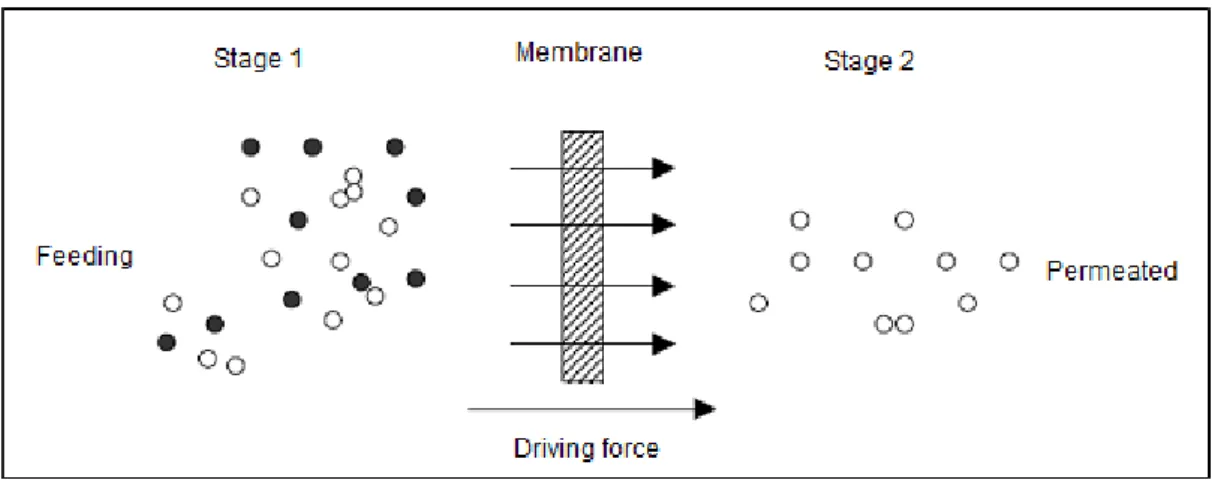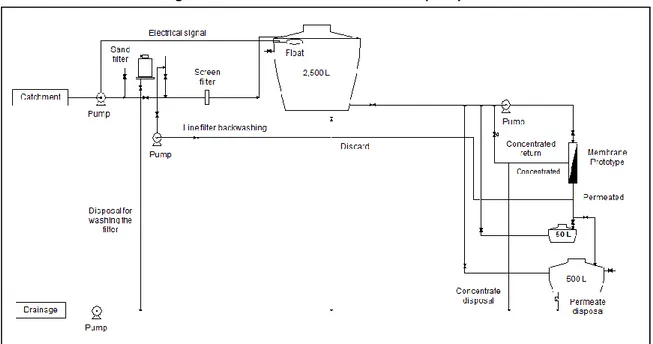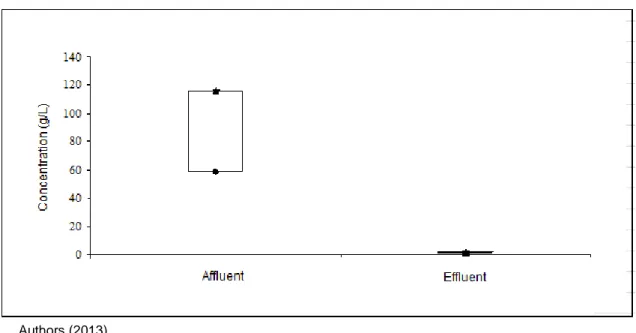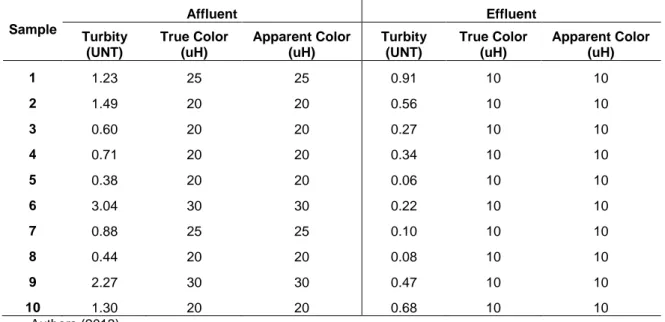____________________
1 E-mail: michelezat@yahoo.com.br
Avenida Bento Gonçalves, 9500, Porto Alegre, RS. 2 E-mail: okonrad@univates.br 3 E-mail: uwe.strothmann@w-hs.de 4 E-mail: alberto.bezama@gmail.com 5 E-mail: marlucelumi@gmail.com
REMOVAL OF IRON AND MANGANESE BY NANOFILTRATION
PILOT SYSTEM
Michely Zat
1, Odorico Konrad
2, Uwe Strotmann
3, Alberto Bezama
4, Marluce
Lumi
5______________________________________________________________________________ Abstract: By human activities numerous organic and inorganic pollutants and nutrients such as nitrogen and
phosphor containing compounds have been discharged into water causing widespread contamination problems. Ionic compounds such as iron (Fe2+) and manganese (Mn2+) are frequently found in discharges of pollutants. Therefore, they may deteriorate the organoleptic characteristics of drinking water, causing taste, color and odor. These compounds are not completely removed by conventional water treatment plant processes and remain in the water. Thus this study was performed to evaluate the efficiency of a nanofiltration process with respect to the removal of iron and manganese. The nanofiltration system proved to be very efficient and could effectively increase the water quality.
Keywords: Public health. Pollution. Odor. Water treatment. Membrane.
______________________________________________________________________________ 1 Introduction
The process of environmental
pollution is one of the most severe problems that affect society today. It has been observed that a major part of aquatic ecosystems is damaged, mainly due to contamination resulting from population growth and industrial production activities in general. Deficient sanitation services, together with increasing industrial activity, growing urbanization and an extension of agricultural areas are among the largest contributors to pollution of water sources and thus promoting the deterioration of the organoleptic characteristics of drinking water. Until the mid-twentieth century, the quality of drinking water was mainly evaluated by its organoleptic characteristics like a pleasant taste and an absence of odor and color. However, this type of evaluation revealed unsatisfactory in terms of protecting public health from pathogenic microorganisms and hazardous chemicals in the water and for this reason it is difficult to set up objective standards for water that was intended for human consumption.
While most of the parameters of water quality is supported by defined quality standards, the analysis and evaluation of taste and odor can cause certain difficulties. They are subjective sensations often caused by dissolved impurities and therefore difficult to assess (ECKENFELDER, 1973). Surveys conducted by the American Water Works Association (AWWA, 1995) indicate that the major criterion for water quality relevant for a population is its taste, odor and color. The same survey shows that consumers often buy bottled water when there is some smell or taste. Another survey from 2000 covering more than 160 water supply systems in the U.S. and Canada, found that 44% of consumer complaints are due to taste and odor and 45% to color and turbidity (REISS et al., 2006).
Important factors causing taste, odor and color are iron and manganese ions. Due to the presence of iron and manganese several regions in Brazil have quality problems with its water supply. This fact is either caused by dissolution processes from minerals and rocks during the water passage and by different effluents also contributing to increased concentrations of these metal ions.
High concentrations in drinking water can provoke problems, ranging from stains in sanitary appliances, clothes and housewares, to taste and odor problems (DI BERNARDO; SABOGAL PAZ, 2008). Iron and manganese can be the reason for a yellowish, cloudy or dark water with a bitter and astringent taste (MACEDO, 2001).
Whereas precipitated insoluble
compounds can be easily removed by conventional methods during the water purification process, the removal of soluble manganese and iron salts is much more complicated (VON SPERLING, 2005). In general, the manganese in raw water is present as an insoluble bicarbonate salt. Its concentration is low, ranging from 0 to 5 ppm (BRESAOLA, 1996).
According to Brazilian regulations (BRASIL, 2004), iron and manganese compounds have to be regularly analyzed and controlled. These ions can combine with sulfides which are a well-known cause for odor (ECKENFELDER, 1973). Therefore, the limits for iron and manganese in drinking water are set at, respectively, 2.4 mg. L-1 and 0.4 mg L-1 (BRASIL, 2011).
Conventional treatment processes,
including coagulation, flocculation,
sedimentation, filtration and disinfection, are often ineffective for removing and/or inactivation of compounds that promote the taste, odor and color in water (FERREIRA FILHO; MARCHETTO, 2006). Filtration, ion exchange, stabilization with polyphosphate and the use of zeolite are known processes for the removal of iron and manganese (BENDATI et al., 2005).
New technologies like membrane separation processes have been used more frequently and have gained increasing importance for the retention of contaminants that cannot be removed by conventional treatments (MIERZWA, 2006). In this context, nanofiltration is a process which gives a
water superior to that achieved by
conventional treatment technologies (REISS et al., 1999). Nanofiltration is particularly effective in removing solid particles with a pore size of about 10-9m.
These include organic compounds, products of disinfecting and dissolved organic matter that add color, taste and odor to water
(AWWA, 1995). The nanofiltration
membranes are capable of removing organic compounds with molecular weight ranging from 250 to 1000 g/mol operating at a pressure between 3.5 MPa and 0,5 MPa (EPA, 2003).
The membrane separation process is characterized in that the feed stream is divided into the concentrate stream and permeate stream. This implies that either the current or the concentrated permeate is the result of separation. The solutes and particles retained on the surface are continuously removed from the concentrate which flows tangentially across the membrane surface. The clarified solution flows through the membrane as permeate. Typical for this process are pressure and concentration gradients across the membrane (MULDER, 1997; MIERZWA, 2006). A schematic view is shown in Figure 1. The flow passage through the membrane is always parallel to it, within a pressure vessel.
Figure 1 - Schematic representation of the separation membrane
Authors (2013)
With respect to drinking water, pilot studies are being conducted to examine its technical and economical applicability in the removal of organic compounds, solids, color, taste and odor as well as a softening of the treated water (MIERZWA; HESPANHOL, 2005). Research conducted with this process have shown that a water quality superior to that achieved by conventional treatment technologies can be obtained (REISS et al., 2006).
On the other hand, removal of odorous compounds in drinking water by nanofiltration is poorly documented in the literature. Yoon et al. (2006) studied the
membrane separation processes for
removing compounds that cause alterations in endocrine, pharmaceutical and personal care products. It was observed that 90% of the compounds could be removed, with a removal rate that can reach 80%. Bruchet and Laine (2005) investigated the membrane processes for the removal of taste and odor in water. The authors reported 74 to 88% removal for dioxins and dioxolanes.
Thus, this work aims at evaluating the efficiency of nanofiltration processe for the removal of iron and manganese in a water storage system for the city of Porto Alegre, Rio Grande do Sul (RS), Brazil. The
water stored in this dam has high
concentrations of iron and manganese, especially in periods of higher temperatures (DMAE, 2012).
2 Material and methods
A prototype of a nanofiltration system was installed in the water treatment plant (WTP) of the Lomba do Sabão DMAE (Municipal Department of Water and Sewers)
of Porto Alegre-RS.
This pilot plant consisted of a multi-stage centrifugal pump, a pressure vessel and a nanofiltration membrane (type DK-4040, spiral wound). The flow rate of the membrane was 28L/h m² at 25ºC at a pressure of 517 kPa.
2.1 Water supply
The water, which was directed to the membrane system was taken from the raw water outlet of Effluent Treatment Station “Lomba do Sabão”. The storage system of “Lomba do Sabão” provides 3.6% of the water for the public supply of the city of Porto
Alegre. It has an average volume of 13 million cubic meters and currently works with a maximum flow of 400 L/s (DMAE, 2012).
2.2 Water treatment system
For the experiments performed the raw water was stored in a 2500 L polyethylene tank. Before entering this tank, the water passed through a sand filter (filtration area: 0.19 m²) and a Y type filter to remove particles larger than 100 μm. Sodium hypochlorite was added to the water (final concentration 1.0 mg/L) to prevent biofilm growth on the surface of the nanofiltration membrane.
The water was then pumped to the pilot plant; the effluent was led to a storage tank. In this tank samples were collected for analysis. Figure 2 shows the flowchart of operation of the nanofiltration system.
Once the pilot plant worked and provided a continuous water stream, samples were collected and analysed for iron and manganese. In order to provide reliable results, duplicate analyses were performed. The analyses were carried out during four months.
2.3 Pilot plant of nanofiltration membrane The nanofiltration system (Osmonics DK4040F) had an effective membrane area of 8.36 m2. The system could remove organic compounds with molecular weight between 250 and 1000 g.mol-1 and some ions (INVICT, 2008). The typical operating pressure was between 810 and 900kPa at a flow rate of water 4 L.min-1. The pressure across the membrane could vary due to differences in quality of the influent water. The pressure and flow rate was maintained at a constant value with the help of discharge valves on the permeate and concentrate line, respectively. Permeate and concentrate flow rates were quantified by meter type flowmeters.
During the study 10 single tests were conducted, each lasting 125 minutes. The tests were conducted without recirculation of the concentrate. The permeate was collected in a 500 L storage tank. 60% of the water directed to the system represented the concentrate, the remaining 40% being the permeate. These values were in good agreement with the membrane specifications.
Figure 2 - Flowchart of the nanofiltration pilot plant
Authors (2013)
2.4 Analytical procedures
Water samples were taken before and after passing the nanofiltration system. These samples were analyzed for iron and manganese, real and apparent color as well as turbidity.
All water samples were collected in 30 mL vials and preserved immediately after collection, according to the methodology of the Standard Methods for the Examination of Water and Wastewater (BAO et al., 1997; STANDARD METHODS, 1998; LIOYD et al., 1998).
Turbidity was determined with a turbidimeter (Instrutherm DR950 model TD-200). Real and apparent color determinations were performed with a colorimeter (Orbeco Hellige Aqua Tester). The detection limit was 10uH.
Iron and manganese were analyzed by atomic absorption spectrophotometry (Perkin-Elmer B, Model 2380) at wavelengths
of 240.3 nm (iron) and 279.5 nm
(manganese).
3 Results and discussions
3.1 Removal of iron and manganese in the nanofiltration system
Iron and manganese could be very effectively removed by the nanofiltration process. The extent of removal was greater
than 99% for iron and 75% for manganese (Figures 3 and 4).
3.2 Results of real and apparent color and turbidity
Removal of turbidity and color (real and apparent color) are shown in Table 1. It can be stated that 67% turbidity is being removed whereas 52% real and apparent color are removed.
According to data shown, a high efficiency in the removal of manganese and especially iron by nanofiltration system could be stated. The removal achieved for manganese and iron were 75% and 99%, respectively, showing a good efficiency of the nanofiltration. In general, manganese present in raw water is rather low, ranging from 0 to 5 ppm (BRESAOLA, 1996). To meet the demands of the consumer concerning organoleptic purposes of water, nanofiltration revealed to be a promising technology for the
removal of iron and manganese
contaminants.
The membrane used has a cut-off between 250 to 1000 Daltons according to the manufacturer. Therefore, by this cut off process iron and manganese could be effectively removed. On the other hand, it is also possible that other mechanisms can be responsible for removal processes. WEF (2006) mentions that mechanisms such as adsorption and cake formation also play a
crucial role in the removal of compounds of lower molecular weight.
The turbidity, color real and apparent color removal turned out to be satisfactory.
The effluent analysis data for real and apparent color showed values below the detection limit.
Figure 3 - Variations in the concentrations of iron in affluent and effluent of the system of nanofiltration
Authors (2013)
Figure 4 - Varied concentrations of manganese in the affluent and effluent of the system of nanofiltration
Authors (2013)
These data show that the system of nanofiltration membrane separation is efficient to remove smaller solids that cause turbidity and color.
The nanofiltration process can be combined with other pretreatment processes
to eliminate flavor, odor and color problems due to iron and manganese.
All tests were performed as batch tests. In a subsequent step the performance of the nanofiltration system should be tested under continuous operation conditions. Then
variations, fouling rates, and the influence of cleaning processes could be included to give
a most realistic impression of the efficiency of nanofiltration unit.
Table 1 - Variations in concentrations of turbidity, true color and apparent in the affluent and effluent of the nanofiltration system
Sample Affluent Effluent Turbity (UNT) True Color (uH) Apparent Color (uH) Turbity (UNT) True Color (uH) Apparent Color (uH) 1 1.23 25 25 0.91 10 10 2 1.49 20 20 0.56 10 10 3 0.60 20 20 0.27 10 10 4 0.71 20 20 0.34 10 10 5 0.38 20 20 0.06 10 10 6 3.04 30 30 0.22 10 10 7 0.88 25 25 0.10 10 10 8 0.44 20 20 0.08 10 10 9 2.27 30 30 0.47 10 10 10 1.30 20 20 0.68 10 10 Authors (2013) 4 Conclusions
The nanofiltration system revealed a good performance, both in terms of operation stability and the quality of the produced water. Iron and manganese were effectively removed exceeding 75% and 99% of
removal, respectively. Turbidity was
significantly reduced exceeding 67%, and real and apparent color could also be removed 52%. May be greater than this due to the detection limit of the apparatus.
In nanofiltration system, other mechanisms besides physical retention may affect the removal of contaminants present in
the influent water. These are cake formation and adsorption processes.
Manganese and iron ions cause numerous problems in the treatment of water due to the formation of color and taste in the water. Thus, it is interesting to search for alternatives to conventional treatment technologies to provide the consumer a high quality drinking water.
In addition to iron and manganese removal nanofiltration membranes show a high potential for the removal of a number of dissolved compounds whose presence in the water supply is associated with public health concerns.
______________________________________________________________________________ 5 Remoção de ferro e manganês por um sistema piloto de nanofiltração
Resumo: Devido às atividades humanas, inúmeros poluentes e nutrientes como nitrogênio e fósforo
contendo compostos orgânicos e inorgânicos são descarregados na água causando problemas de contaminação generalizada. Compostos iônicos, como o ferro (Fe2 +) e o manganês (Mn2 +) são frequentemente encontrados em descargas de poluentes. Portanto, estes compostos podem deteriorar as características organolépticas da água potável causando sabor, cor e odor. Eles não são completamente removidos por processos de tratamento de água convencionais e permanecem na água. Assim, este estudo foi realizado para avaliar a eficiência de um processo de nanofiltração no que diz respeito à remoção de ferro e manganês. O sistema de nanofiltração provou ser muito eficaz e pode efetivamente aumentar a qualidade da água.
Palavras-chaves: Saúde pública. Poluentes. Odor. Tratamento de água. Membrana.
6 References
AMERICAN WATER WORKS ASSOCIATION (AWWA). 1995 Advances in taste and odor
treatment and control. Denver, AWWARF.
BAO, M.L.; BARBIERI, K.; BURRINI, K.;
GRIFFINI, O.; PANTANI, F. 1997 Determination of trace levels of taste and odor compounds in water by micro extraction and gas
chromatography-ion-trap detection-mass spectrometry. Water
Research, 31 (7), p. 1719-1727.
BENDATI, M. M.; MAIZONAVE, C. R. M.; FACCHIN, J. M. J.; THEWES, M. R.; ADAIME, H. S. 2005 Ocorrência de floração de cianobactéria In: XXIII Congresso Brasileiro de Engenharia
Sanitária e Ambiental, Campo Grande, MT.
Anais... Campo Grande: ABES 2005.
BRASIL. Ministério da Saúde. 2004 Agência Nacional de Vigilância Sanitária. Portaria nº 518, de 2004. Estabelece os procedimentos e
responsabilidades relativos ao controle e
vigilância da qualidade da água para consumo humano e seu padrão de potabilidade, e dá outras providências. Diário Oficial da União, Brasília, DF.
BRASIL. Ministério da Saúde. 2011 Agência Nacional de Vigilância Sanitária. Portaria n° 2.914, de 12 de dezembro de 2011. Dispõe sobre os procedimentos de controle e de vigilância da qualidade da água para consumo humano e seu padrão de potabilidade. Diário Oficial da União, Brasília, DF.
BRESAOLA, J.R. R. Remoção de ferro e
manganês pelo tratamento de águas de
abastecimento com permanganato de
potássio. Doctoral Thesis in Engineering
Hydraulics and Sanitation, School of Civil Engineering, University of Campinas, São Paulo, Brazil, 1996.
BRUCHET, A.; LAÎNÉ, J. M. Efficiency of membrane processes for taste and odor removal.
Water Science and Technology, 51(6-7), p.
257-265, 2005.
DI BERNARDO, L.; SABOGAL PAZ, L. P.
Seleção de Tecnologias de Tratamento de Água. LDiBe, São Carlos, 2008.
DMAE. Qualidade da água e problemas de operação de tratamento do DMAE, 2012.
Available in:
<http://www.portoalegre.rs.gov.br/dmae/default. php?p_secao=171>. Accessed 31 July 2013.
ECKENFELDER, Jr. W.W. Water quality
engineering for practicing engineers. Barnes
and Noble, Inc. New York, 1973.
EPA. Membrane filtration guidance manual Office of water. United States Environmental
Protection Agency. EPA 815-D-03-008 (Proposal Draft), 2003.
FERREIRA FILHO, S. S.; MARCHETTO, M. Otimização, Multi-Objetivo de Estações de
Tratamento de Águas de Abastecimento:
Remoção de Turbidez, Carbono Orgânico e Gosto e Odor. Revista de Engenharia Sanitária e
Ambiental, 11(1), p. 7-15, 2006.
INVICT. Manual de Procedimento de Operação
de Membranas D-Series, São Paulo, 2008.
LIOYD, S.W.; LEA, J.M.; ZIMBA, P.V.; GRIMM, C.C. Rapid analysis of geosmin and 2-methylisoborneol in water using solid phase micro extraction procedures. Water Research, 32(7), p. 2140-2146, 1998.
MACEDO, J.A.B. Águas & Águas. São Paulo: Varela, 2001.
MIERZWA, J. C. Processos de Separação por Membranas para tratamento de Água. In: Pádua V. L. (coord.). Contribuição ao Estudo da
remoção de Cianobactérias e
Microcontaminantes Orgânicos por meio de Técnicas de Tratamento de Água para Consumo Humano. Belo Horizonte. Cap. 8,
2006.
MIERZWA, J. C.; HESPANHOL, L. I. Água na
Indústria – Uso racional e reuso, São Paulo:
Oficina de Textos, 2005.
MULDER, M. Basic Principles of Membrane
Technology. 2nd, Kluwer Academic Publishers,
Netherlands, 1997.
REISS, C. R.; ROBERT, C.; OWEN, C.; TAYLOR, J. S. Control of MIB, Geosmin and TON by membrane systems. Journal of Water Supply
Research and Technology, 55(2),p. 95-108,
2006.
REISS, C. R.; TAYLOR, J. S.; ROBERT, C. Surface water treatment using nanofiltration pilot
testing results and design considerations.
Elsevier Science B. V. Desalination, 125, p.
97-112, 1999.
STANDARD METHODS FOR THE
EXAMINATION OF WATER AND WASTEWATER 20th edn, American Public Health Association, Washington DC, USA, 1998.
VON SPERLING, M. Visão Integrada do
Saneamento por Bacia Hidrográfica e o
Monitoramento da sua Qualidade. In: Andreoli, C.V.; Willer, M. Gerenciamento do Saneamento
em Comunidades Planejada. Série Cadernos
WATER ENVIROMENT FEDERATION (WEF).
Membrane systems for wastewater treatment.
Alexandria, VA: WEF, 2006.
YOON, Y.; YOON, P.; WESTERHOFF, S.; SNYDER, E. Nanofiltration and ultrafiltration of endocrine disrupting compounds, pharmaceuticals
and personal care products. Journal of



